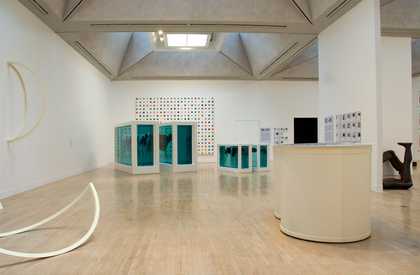
View of the Turner Prize: A Retrospective exhibition
Photo: Tate Photography © Tate 2007
The reinvented Turner Prize quickly established itself as a major art event. However, at times, it seemed that the cynicism of the press was out of step with the receptiveness of the public. For the artists the larger gallery space devoted to the exhibition was often a greater incentive to take part than the prize itself.
The exhibitions from 1992–4 seemed evenly balanced with the inclusion of painting, sculpture and installation as well as video art for the first time in 1994. Nevertheless, some objections were raised over the prevalence of art that was deemed ‘too conceptual’. For instance in 1993, the use of unconventional art materials – Vong Phaophanit’s installation comprising rice and neon and Rachel Whiteread’s plaster cast of the internal space of a room – became a point of contention.
By 1994 the prize was ten years old and Antony Gormley was celebrated as a popular choice, as his work had already proven its appeal with the British public. The inclusion of Damien Hirst’s Mother and Child, Divided in 1995 brought an unprecedented peak in visitor numbers and created tabloid excitement, adding to both the artist’s and the prize’s notoriety.
Artists and works on display:
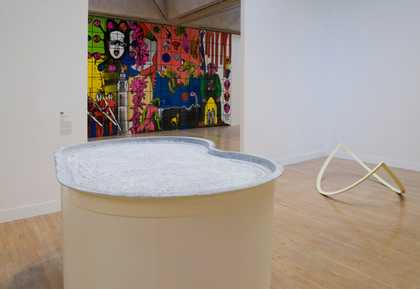
View of Turner Prize: A Retrospective exhibition
Photo: Tate Photography © Tate 2007
Grenville Davey
Dry Table 1990
Painted galvanised steel and salt
Tate, Purchased 1992
Sharp 1992
Four parts
Painted steel
Collection of the artist
The form and scale of Dry Table is at once suggestive of domestic furniture and an industrial object. The smooth finish of the curved sides is deliberately contrasted with the pitted surface of the crystallised salt. Like other sculptures by Davey from this period, this work creates a tension between the idea of the art object as pure form and as a representation of reality.
Sharp is made up of four parts that exist almost as three-dimensional line drawings in space. Their placement is reconfigured each time they are shown according to the architectural setting. The viewer’s perception of each individual element and their relationship to each other changes as they move through the installation.
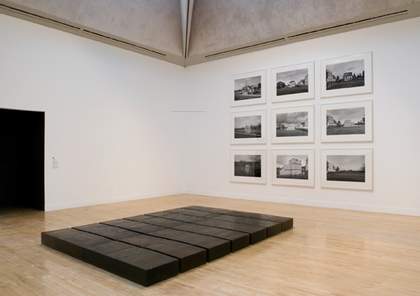
View of sculpture and photographs by Rachel Whiteread in Turner Prize: A Retrospective exhibition
Photo: Tate Photography © Tate 2007
Rachel Whiteread
Untitled (Floor) 1994–5
Polyester resin
Tate.
House 1993
Nine black and white photographs
Courtesy Michael Hoppen Contemporary
Photo © John Davies
In the late 1980s, Rachel Whiteread began casting the ‘negative spaces’ inside and underneath domestic objects and soon moved on to architectural features and entire rooms. Works such as Untitled (Floor) suggest the restrained aesthetic of Minimalism in their form while bearing traces of human occupation.
The photographs on display here document House, a public sculpture made by casting the interior of a condemned terrace house in East London. She created the work by spraying liquid concrete into the building’s empty shell before its walls were removed. The work became a temporary monument to lost communities and a focus for public debate before it was demolished in January 1994.
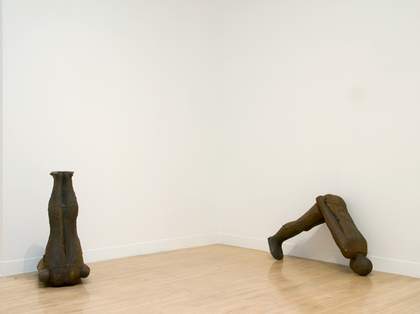
View of Turner Prize: A Retrospective exhibition with Antony Gormley's Testing a World View 1993
Photo: Tate Photography © Tate 2007
Antony Gormley
Testing a World View 1993
Cast iron
Tate. Presented by the artist 2005
Testing a World View consists of five identical iron figures, rigidly bent at the waist, based on a cast made from Gormley’s body. They are installed in various positions that relate to the architecture of the space.
The artist comments, ‘The work is a kind of psychological Cubism. An identical body cast made from the interior of a body case five times, which I then try to test against architecture. The piece expresses the polymorphousness of the self; that in different places we become different and I think this is physical.’ This work was shown in the 1994 Turner Prize exhibition.
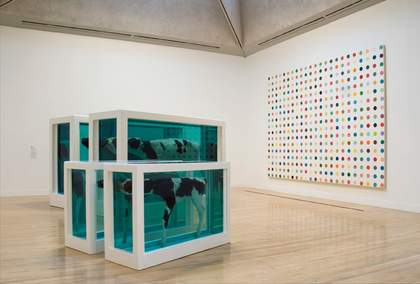
View of Turner Prize: A Retrospective with Damien Hirst's Mother and Child, Divided and Argininosuccinic Acid
Photo: Tate Photography © Tate 2007
Damien Hirst
Mother and Child, Divided
Exhibition copy 2007 (original 1993)
Steel, GRP composites, glass, silicon,
cow, calf and formaldehyde solution
Collection of the artist
Argininosuccinic Acid 1995
Gloss household paint on canvas
Pinchuk Art Centre Collection, Kiev, Ukraine

Mother and Child, Divided exhibition copy 2007
(original 1993) Steel, GRP composites, glass, silicon, cow, calf and formaldehyde solution
Collection of the artist
Photo: Tate Photography © Tate 2007
First exhibited at the Venice Biennale and subsequently in the 1995 Turner Prize exhibition, Mother and Child, Divided is a confrontational and now iconic work that has always provoked strong responses. Hirst has commented that he, ‘uses shock almost as a formal element … not so much to thrust his work in the public eye … but rather to make aspects of life and death visible.’ Using provocative materials, he continually explores the theme of mortality in a brutally honest and thought-provoking manner.
This painting on display was also included in the 1995 exhibition and is part of Hirst’s series of ‘spot paintings’. The pharmaceutical title invokes the idea of the spots as pills, but in fact the colours are arbitrary.
